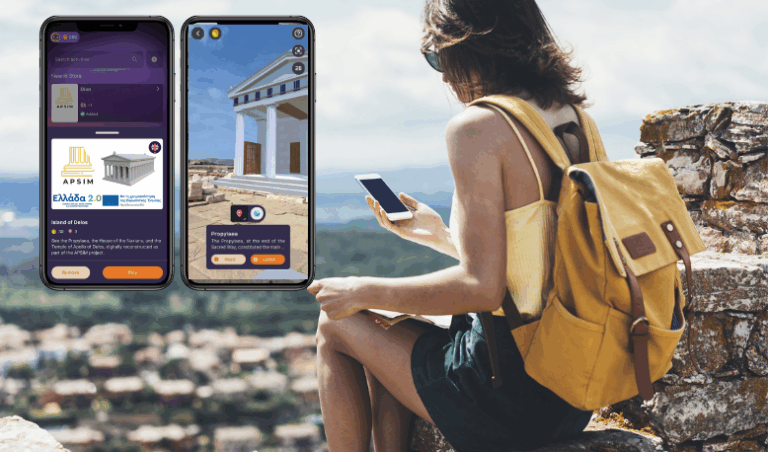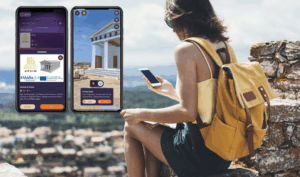Digital bridges to the past through the CirculAR app by ICCS/NTUA
In the heart of the Aegean, where — according to myth — Leto gave birth to Apollo and Artemis, Delos rises once more, the “holiest of islands.” This time, however, it comes alive not just through its ruins but through technology.
The long, narrow strip of land that has stood silent for centuries under the blazing sun and the light reflected on its stones, regains its sound, color, and movement — through the innovative CirculAR app — and transforms into an interactive field of experience.
For centuries, Delos, the sacred island of Apollo, was a reference point of antiquity. From the Early Cycladic settlement on Mount Kynthos to its heyday as a free Roman port, it was a center of commerce, worship, and culture. The Temple of Apollo, the Stoa and House of the Naxians, the Propylaea, the Terrace of the Lions — all of these, today discernible only as silent stones, can now be brought back to life through the screen of a visitor’s mobile phone.
The CirculAR app, developed within the framework of the European APSIM project and coordinated by the I-SENSE research group of ICCS (Institute of Communication and Computer Systems of NTUA), makes the invisible visible.
With the help of augmented reality (AR/XR), visitors can explore the monuments of Delos just as they were in their prime. Through their mobile device, they see columns rising again and temples gleaming under the Aegean light. With a simple smartphone or tablet, users can “revive” the monuments, view them in 3D, rotate them, explore around them, and enjoy a completely new, immersive visiting experience.
“Extended reality technologies (VR/AR/MR) allow us to retrieve what no longer exists before our eyes and reintegrate it into the physical space. How? By using the camera and algorithms for spatial mapping and position tracking, the app ‘reads’ the landscape and digitally places the monuments or traces of the past exactly where they once stood. So, the visitor sees not just stones and foundations, but temples rising, stoas taking shape, and streets coming alive again,” explains Dr. Tina Katika, head of the XR department of I-SENSE and a member of the APSIM project team.
The APSIM project was implemented by a consortium of six partners: the Institute of Communication and Computer Systems (ICCS) of NTUA, the companies GEOANALYSIS SA and Comic IKE, the Ephorate of Antiquities of the Cyclades, the Department of History and Archaeology of AUTh (University Excavation of Dion), and the Epigraphic Museum of Athens.
Beyond a technological achievement, the creation of the app is the result of a multifaceted collaboration among professionals from completely different worlds: archaeologists, historians, computer engineers, interface designers, educators, and experts in cultural policy.
“In the meeting of these fields, something unique was born: a common way to narrate the past using the tools of the future. This interdisciplinarity, though demanding and often complex — as it requires bridging different methods, languages, and perspectives — proves invaluable. Thanks to this creative synergy, technology gains depth, history gains a voice, and our cultural heritage is preserved and revived in an authentic, credible, accessible, and experiential way. This project is a reminder that true innovation does not emerge solely from algorithms but from the meeting of people and knowledge serving the same purpose: the preservation and dissemination of culture,” notes Dr. Angelos Amditis, project coordinator and Director of Research and Development at ICCS/NTUA. “Initiatives like this are vital for Greece, a country where the traces of the ancient world are everywhere, but understanding them requires reliable sources and modern tools.”
The innovation of the app is not limited to the island of Apollo. Through the same technology, users can also explore other monuments in Greece, such as the Episcopal Basilica of Dion in Pieria or the Arsenal of Philon — an important structure from 347 BC that preserved the technological memory of ancient warships. Its virtual reconstruction was based on a surviving inscription now exhibited at the Epigraphic Museum of Athens.
“At the heart of the app we developed — through two years of intensive research — are gamification techniques and 3D modeling that turn every visit into a discovery game, combined with a rigorous scientific validation process ensuring that what we ‘see’ is also accurately documented. The user participates, learns, and connects emotionally with the monument, transforming historical memory into a personal experience. And that is the goal: to reconnect creatively with the past,” concludes Dr. Tina Katika.
The CirculAR app is available for free on Android devices through the Google Play Store and on iOS devices through the App Store, offering everyone the opportunity to admire selected monuments in 3D — from anywhere.







